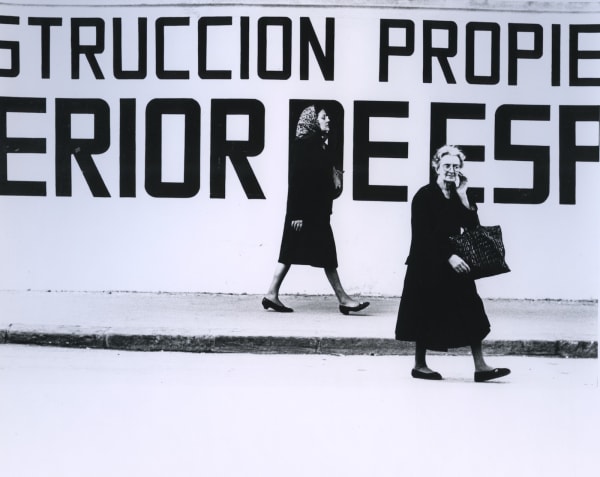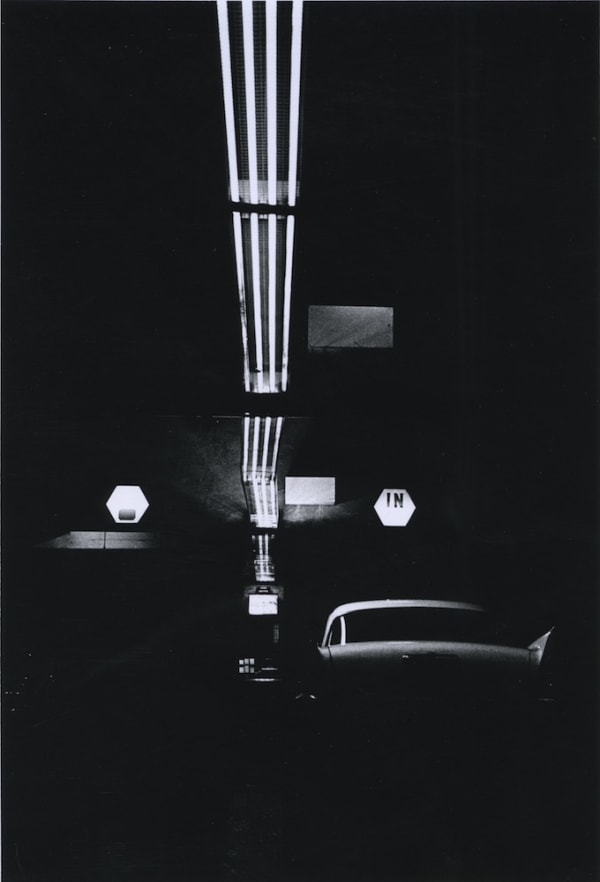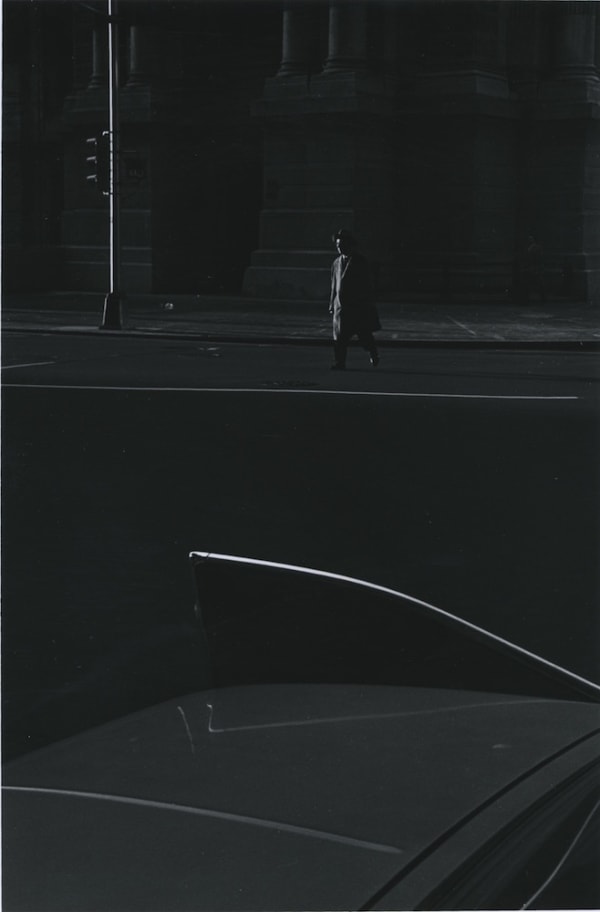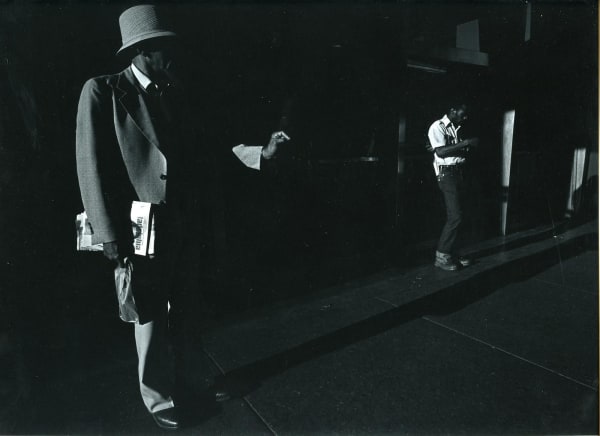Ray K. Metzker, Abstractions
Dim. papier: 25,4 x 20,4 cm
Ray K. Metzker holds a special place in the history of American photography. A fixture in the best-known institutions, his work, consisting exclusively of black and white images, is completely representative of an entire generation of profoundly experimental photographers. Born in 1931, Metzker was deeply influenced by his studies at Chicago’s Institute of Design. For over fifty years he continued to innovate, often working in his dark room with only his intuition as a guide. His work on negatives evolved slowly over the course of many years. Montages, juxtaposition, multiple exposures, double exposures... Metzker set no limits on his creativity. With the generous assistance of Laurence Miller in New York, we invite you to discover the sixty prints in our exhibit, which represent a small part of the rich, fertile work of an immense American artist.
 Ray K. MetzkerCouplets, New YorkTirage gélatino-argentique d'époque, réalisé par l'artiste22,7 x 15,5 cm
Ray K. MetzkerCouplets, New YorkTirage gélatino-argentique d'époque, réalisé par l'artiste22,7 x 15,5 cm
Dim. papier: 25,4 x 20,4 cm Ray K. MetzkerDouble Frame, New YorkTirage gélatino-argentique d'époque, réalisé par l'artiste23 x 13,7 cm
Ray K. MetzkerDouble Frame, New YorkTirage gélatino-argentique d'époque, réalisé par l'artiste23 x 13,7 cm
Dim. papier: 22,5 x 18 cm Ray K. MetzkerChicagoTirage gélatino-argentique d'époque, réalisé par l'artiste18,8 x 18,5
Ray K. MetzkerChicagoTirage gélatino-argentique d'époque, réalisé par l'artiste18,8 x 18,5
Dim. papier: 20,3 x 25,4 Ray K. MetzkerPhiladelphiaTirage gélatino-argentique postérieur, réalisé par l'artiste9,3 x 11,5 cm
Ray K. MetzkerPhiladelphiaTirage gélatino-argentique postérieur, réalisé par l'artiste9,3 x 11,5 cm
Dim. papier: 20,3 x 25,4 cm Ray K. MetzkerWanderings, Atlantic CityTirage gélatino-argentique postérieur, réalisé par l'artiste11,6 x 15,2 cm
Ray K. MetzkerWanderings, Atlantic CityTirage gélatino-argentique postérieur, réalisé par l'artiste11,6 x 15,2 cm
Dim. papier: 20,3 x 25,4 cm Ray K. MetzkerChicagoTirage gélatino-argentique d'époque, réalisé par l'artiste18,9 x 18,6 cm
Ray K. MetzkerChicagoTirage gélatino-argentique d'époque, réalisé par l'artiste18,9 x 18,6 cm
Dim. papier: 20,3 x 25,4 cm Ray K. MetzkerPhiladelphia: Double FrameTirage gélatino-argentique d'époque, réalisé par l'artiste15,6 x 22,6 cm
Ray K. MetzkerPhiladelphia: Double FrameTirage gélatino-argentique d'époque, réalisé par l'artiste15,6 x 22,6 cm
Dim. papier: 20,3 x 25,4 cm Ray K. MetzkerPhiladelphiaTirage gélatino-argentique d'époque, réalisé par l'artiste12 x 17,8 cm
Ray K. MetzkerPhiladelphiaTirage gélatino-argentique d'époque, réalisé par l'artiste12 x 17,8 cm
Dim. papier: 20,3 x 25,4 cm Ray K. MetzkerEarly PhiladelphiaTirage gélatino-argentique postérieur, réalisé par l'artiste15,8 x 23 cm
Ray K. MetzkerEarly PhiladelphiaTirage gélatino-argentique postérieur, réalisé par l'artiste15,8 x 23 cm
Dim. papier: 20,3 x 25,4 cm Ray K. MetzkerValencia, SpainTirage gélatino-argentique d'époque, réalisé par l'artiste17,9 x 22,5 cm
Ray K. MetzkerValencia, SpainTirage gélatino-argentique d'époque, réalisé par l'artiste17,9 x 22,5 cm
Dim. papier: 20,3 x 25,4 cm Ray K. MetzkerPhiladelphiaTirage gélatino-argentique d'époque, réalisé par l'artiste15,1 x 22,2 cm
Ray K. MetzkerPhiladelphiaTirage gélatino-argentique d'époque, réalisé par l'artiste15,1 x 22,2 cm
Dim. papier: 20,3 x 25,4 cm Ray K. MetzkerChicago - LoopTirage gélatino-argentique d'époque, réalisé par l'artiste18 x 18 cm
Ray K. MetzkerChicago - LoopTirage gélatino-argentique d'époque, réalisé par l'artiste18 x 18 cm
Dim. papier: 20,3 x 25,4 cm Ray K. MetzkerChicagoTirage gélatino-argentique d'époque, réalisé par l'artiste18,9 x 18,5 cm
Ray K. MetzkerChicagoTirage gélatino-argentique d'époque, réalisé par l'artiste18,9 x 18,5 cm
Dim. papier: 20,3 x 25,4 cm Ray K. MetzkerPhiladelphiaTirage gélatino-argentique d'époque, réalisé par l'artiste15,2 x 22,4 cm
Ray K. MetzkerPhiladelphiaTirage gélatino-argentique d'époque, réalisé par l'artiste15,2 x 22,4 cm
Dim. papier: 20,3 x 25,4 cm Ray K. MetzkerPhiladelphiaTirage gélatino-argentique d'époque, réalisé par l'artiste15,1 x 22,3 cm
Ray K. MetzkerPhiladelphiaTirage gélatino-argentique d'époque, réalisé par l'artiste15,1 x 22,3 cm
Dim. papier: 20,3 x 25,4 cm Ray K. MetzkerChicago LoopTirage gélatino-argentique d'époque, réalisé par l'artiste18,8 x 18,7 cm
Ray K. MetzkerChicago LoopTirage gélatino-argentique d'époque, réalisé par l'artiste18,8 x 18,7 cm
Dim. papier: 20,3 x 25,4 cm Ray K. Metzker, Early Philadelphia, 1963
Ray K. Metzker, Early Philadelphia, 1963 Ray K. MetzkerCity Square, Early PhiladelphiaTirage gélatino-argentique postérieur, réalisé par l'artiste14,9 x 22,6 cm
Ray K. MetzkerCity Square, Early PhiladelphiaTirage gélatino-argentique postérieur, réalisé par l'artiste14,9 x 22,6 cm
Dim. papier: 20,2 x 25,4 cm Ray K. MetzkerPortugalTirage gélatino-argentique d'époque, réalisé par l'artiste14,3 x 21,9 cm
Ray K. MetzkerPortugalTirage gélatino-argentique d'époque, réalisé par l'artiste14,3 x 21,9 cm
Dim. papier: 20,2 x 25,4 cm Ray K. MetzkerPhiladelphiaTirage gélatino-argentique d'époque, réalisé par l'artiste15,5 x 22,5 cm
Ray K. MetzkerPhiladelphiaTirage gélatino-argentique d'époque, réalisé par l'artiste15,5 x 22,5 cm
Dim. papier: 20,2 x 25,4 cm Ray K. MetzkerPhiladelphiaTirage gélatino-argentique d'époque, réalisé par l'artiste15,4 x 22,5 cm
Ray K. MetzkerPhiladelphiaTirage gélatino-argentique d'époque, réalisé par l'artiste15,4 x 22,5 cm
Dim. papier: 20,2 x 25,4 cm Ray K. MetzkerPhiladelphiaTirage gélatino-argentique d'époque, réalisé par l'artiste15,1 x 22,3 cm
Ray K. MetzkerPhiladelphiaTirage gélatino-argentique d'époque, réalisé par l'artiste15,1 x 22,3 cm
Dim. papier: 20,2 x 25,4 cm Ray K. MetzkerPhiladelphiaTirage gélatino-argentique d'époque, réalisé par l'artiste15,3 x 22,4 cm
Ray K. MetzkerPhiladelphiaTirage gélatino-argentique d'époque, réalisé par l'artiste15,3 x 22,4 cm
Dim. papier: 20,2 x 25,4 cm Ray K. MetzkerChicagoTirage gélatino-argentique d'époque14,6 x 21,3 cm
Ray K. MetzkerChicagoTirage gélatino-argentique d'époque14,6 x 21,3 cm
Dim. papier: 20,2 x 25,4 cm Ray K. MetzkerLaSalle St., ChicagoTirage gélatino-argentique d'époque, réalisé par l'artiste18,3 x 18,2 cm
Ray K. MetzkerLaSalle St., ChicagoTirage gélatino-argentique d'époque, réalisé par l'artiste18,3 x 18,2 cm
Dim. papier: 20,2 x 25,4 cm Ray K. MetzkerEuropeTirage gélatino-argentique d'époque14,7 x 22,1 cm
Ray K. MetzkerEuropeTirage gélatino-argentique d'époque14,7 x 22,1 cm
Dim. papier: 20,2 x 25,4 cm Ray K. MetzkerPhiladelphiaTirage gélatino-argentique d'époque, réalisé par l'artiste15,4 x 22,4 cm
Ray K. MetzkerPhiladelphiaTirage gélatino-argentique d'époque, réalisé par l'artiste15,4 x 22,4 cm
Dim. papier: 20,2 x 25,4 cm Ray K. MetzkerEarly PhiladelphiaTirage gélatino-argentique d'époque, réalisé par l'artiste18 X 23,1 cm
Ray K. MetzkerEarly PhiladelphiaTirage gélatino-argentique d'époque, réalisé par l'artiste18 X 23,1 cm
Dim. papier: 20,2 x 25,4 cm Ray K. MetzkerEarly PhiladelphiaTirage gélatino-argentique d'époque, réalisé par l'artiste15,2 x 22,4 cm
Ray K. MetzkerEarly PhiladelphiaTirage gélatino-argentique d'époque, réalisé par l'artiste15,2 x 22,4 cm
Dim. papier: 20,2 x 25,4 cm Ray K. MetzkerChicagoTirage gélatino-argentique d'époque, réalisé par l'artiste15,2 x 22,4 cm
Ray K. MetzkerChicagoTirage gélatino-argentique d'époque, réalisé par l'artiste15,2 x 22,4 cm
Dim. papier: 20,2 x 25,4 cm Ray K. MetzkerPhiladelphiaTirage gélatino-argentique postérieur, réalisé par l'artiste15,2 x 22,4 cm
Ray K. MetzkerPhiladelphiaTirage gélatino-argentique postérieur, réalisé par l'artiste15,2 x 22,4 cm
Dim. papier: 20,2 x 25,4 cm Ray K. MetzkerWisconsinTirage gélatino-argentique d'époque, réalisé par l'artiste9,2 x 11,5 cm
Ray K. MetzkerWisconsinTirage gélatino-argentique d'époque, réalisé par l'artiste9,2 x 11,5 cm
Dim. papier: 20,2 x 25,4 cm Ray K. MetzkerUnder the boardwalk, Atlantic CityTirage gélatino-argentique postérieur, réalisé par l'artiste15,2 x 15,2 cm
Ray K. MetzkerUnder the boardwalk, Atlantic CityTirage gélatino-argentique postérieur, réalisé par l'artiste15,2 x 15,2 cm
Dim. papier: 20,3 x 25,4 cm Ray K. MetzkerPhiladelphiaTirage gélatino-argentique d'époque, réalisé par l'artiste15,3 x 22,3 cm
Ray K. MetzkerPhiladelphiaTirage gélatino-argentique d'époque, réalisé par l'artiste15,3 x 22,3 cm
Dim. papier: 20,2 x 25,4 cm Ray K. MetzkerEuropeTirage gélatino-argentique d'époque, réalisé par l'artiste13 x 21,6 cm
Ray K. MetzkerEuropeTirage gélatino-argentique d'époque, réalisé par l'artiste13 x 21,6 cm
Dim. papier: 20,2 x 25,4 cm Ray K. MetzkerPhiladelphiaTirage gélatino-argentique postérieur, réalisé par l'artiste15,1 x 22,5 cm
Ray K. MetzkerPhiladelphiaTirage gélatino-argentique postérieur, réalisé par l'artiste15,1 x 22,5 cm
Dim. papier: 20,2 x 25,4 cm Ray K. MetzkerChicagoTirage gélatino-argentique d'époque, réalisé par l'artiste14,7 x 21,5 cm
Ray K. MetzkerChicagoTirage gélatino-argentique d'époque, réalisé par l'artiste14,7 x 21,5 cm
Dim. papier: 20,2 x 25,4 cm Ray K. MetzkerChicagoTirage gélatino-argentique d'époque, réalisé par l'artiste15,2 x 22,3 cm
Ray K. MetzkerChicagoTirage gélatino-argentique d'époque, réalisé par l'artiste15,2 x 22,3 cm
Dim. papier: 20,2 x 25,4 cm Ray K. MetzkerItalyTirage gélatino-argentique d'époque, réalisé par l'artiste15 x 22,3 cm
Ray K. MetzkerItalyTirage gélatino-argentique d'époque, réalisé par l'artiste15 x 22,3 cm
Dim. papier: 20,2 x 25,4 cm Ray K. MetzkerPhiladelphiaTirage gélatino-argentique d'époque, réalisé par l'artiste18,1 x 23,1 cm
Ray K. MetzkerPhiladelphiaTirage gélatino-argentique d'époque, réalisé par l'artiste18,1 x 23,1 cm
Dim. papier: 20,2 x 25,4 cm Ray K. MetzkerPhiladelphiaTirage gélatino-argentique d'époque, réalisé par l'artiste12,9 x 19 cm
Ray K. MetzkerPhiladelphiaTirage gélatino-argentique d'époque, réalisé par l'artiste12,9 x 19 cm
Dim. papier: 20,2 x 25,4 cm Ray K. MetzkerPhiladelphiaTirage gélatino-argentique d'époque, réalisé par l'artiste15,3 x 22,5 cm
Ray K. MetzkerPhiladelphiaTirage gélatino-argentique d'époque, réalisé par l'artiste15,3 x 22,5 cm
Dim. papier: 20,2 x 25,4 cm Ray K. MetzkerPhiladelphiaTirage gélatino-argentique d'époque, réalisé par l'artiste15,3 x 22,5 cm
Ray K. MetzkerPhiladelphiaTirage gélatino-argentique d'époque, réalisé par l'artiste15,3 x 22,5 cm
Dim. papier: 20,2 x 25,4 cm Ray K. MetzkerPhiladelphiaTirage gélatino-argentique d'époque, réalisé par l'artiste15,3 x 22,5 cm
Ray K. MetzkerPhiladelphiaTirage gélatino-argentique d'époque, réalisé par l'artiste15,3 x 22,5 cm
Dim. papier: 20,2 x 25,4 cm Ray K. MetzkerPhiladelphiaTirage gélatino-argentique d'époque, réalisé par l'artiste15,3 x 22,4 cm
Ray K. MetzkerPhiladelphiaTirage gélatino-argentique d'époque, réalisé par l'artiste15,3 x 22,4 cm
Dim. papier: 20,2 x 25,4 cm Ray K. MetzkerUnder the Boardwalk, Atlantic CityTirage gélatino-argentique postérieur, réalisé par l'artiste17,5 x 17,7 cm
Ray K. MetzkerUnder the Boardwalk, Atlantic CityTirage gélatino-argentique postérieur, réalisé par l'artiste17,5 x 17,7 cm
6.69 x 6.69 in
Dim. papier: 20,2 x 25,4 cm Ray K. MetzkerMarseille, FranceTirage gélatino-argentique d'époque, réalisé par l'artiste14,8 x 22,6 cm
Ray K. MetzkerMarseille, FranceTirage gélatino-argentique d'époque, réalisé par l'artiste14,8 x 22,6 cm
Dim. papier: 20,2 x 25,4 cm Ray K. MetzkerPhiladelphiaTirage gélatino-argentique postérieur, réalisé par l'artiste15,4 x 22,8 cm
Ray K. MetzkerPhiladelphiaTirage gélatino-argentique postérieur, réalisé par l'artiste15,4 x 22,8 cm
Dim. papier: 17,4 x 25,4 cm Ray K. MetzkerAtlantic CityTirage gélatino-argentique postérieur, réalisé par l'artiste22,1 x 22,8 cm
Ray K. MetzkerAtlantic CityTirage gélatino-argentique postérieur, réalisé par l'artiste22,1 x 22,8 cm
Dim. papier: 35,5 x 27,6 cm Ray K. MetzkerCity Whispers, PhiladelphiaTirage gélatino-argentique postérieur, réalisé par l'artiste30,6 x 17,2 cm
Ray K. MetzkerCity Whispers, PhiladelphiaTirage gélatino-argentique postérieur, réalisé par l'artiste30,6 x 17,2 cm
Dim. papier: 35,4 x 27,7 cm Ray K. MetzkerPhiladephia: City WhispersTirage gélatino-argentique d'époque, réalisé par l'artiste31,2 x 20,6 cm
Ray K. MetzkerPhiladephia: City WhispersTirage gélatino-argentique d'époque, réalisé par l'artiste31,2 x 20,6 cm
Dim. papier: 35,5 x 27,6 cm Ray K. MetzkerCity Whispers, PhiladelphiaTirage gélatino-argentique d'époque, réalisé par l'artiste21 x 29,7 cm
Ray K. MetzkerCity Whispers, PhiladelphiaTirage gélatino-argentique d'époque, réalisé par l'artiste21 x 29,7 cm
8.27 x 11.42 in
Dim. papier: 27,6 x 35,5 cm Ray K. MetzkerCity Whispers, PhiladelphiaTirage gélatino-argentique postérieur, réalisé par l'artiste30,2 x 20,8 cm
Ray K. MetzkerCity Whispers, PhiladelphiaTirage gélatino-argentique postérieur, réalisé par l'artiste30,2 x 20,8 cm
Dim. papier: 35,5 x 27,6 cm Ray K. MetzkerCity Whispers, PhiladelphiaTirage gélatino-argentique d'époque, réalisé par l'artiste30,3 x 22 cm
Ray K. MetzkerCity Whispers, PhiladelphiaTirage gélatino-argentique d'époque, réalisé par l'artiste30,3 x 22 cm
Dim. papier: 35,4 x 27,5 cm Ray K. MetzkerPhiladelphia: City WhispersTirage gélatino-argentique d'époque, réalisé par l'artiste29,7 x 20 cm
Ray K. MetzkerPhiladelphia: City WhispersTirage gélatino-argentique d'époque, réalisé par l'artiste29,7 x 20 cm
Dim. papier: 35,5 x 27,6 cm Ray K. MetzkerPhiladelphia: City WhispersTirage gélatino-argentique postérieur, réalisé par l'artiste30,6 x 20,4 cm
Ray K. MetzkerPhiladelphia: City WhispersTirage gélatino-argentique postérieur, réalisé par l'artiste30,6 x 20,4 cm
Dim. papier: 35,5 x 27,6 cm Ray K. MetzkerChicagoTirage gélatino-argentique postérieur, réalisé par l'artiste22 x 16 cm
Ray K. MetzkerChicagoTirage gélatino-argentique postérieur, réalisé par l'artiste22 x 16 cm
Dim. papier: 20,2 x 25,2 cm Ray K. Metzker, Europe, Marseille, France, 1961
Ray K. Metzker, Europe, Marseille, France, 1961 Ray K. MetzkerChicagoTirage gélatino-argentique d'époque, réalisé par l'artiste34,2 x 23,6 cm
Ray K. MetzkerChicagoTirage gélatino-argentique d'époque, réalisé par l'artiste34,2 x 23,6 cm
Dim. papier: 35,2 x 27,7 cm Ray K. MetzkerCoupletTirage gélatino-argentique d'époque, réalisé par l'artiste14,2 x 22,7 cm
Ray K. MetzkerCoupletTirage gélatino-argentique d'époque, réalisé par l'artiste14,2 x 22,7 cm
Dim. papier: 20,3 x 25,4 cm Ray K. MetzkerAlmeria, SpainTirage gélatino-argentique d'époque, réalisé par l'artiste20 x 13,8 cm
Ray K. MetzkerAlmeria, SpainTirage gélatino-argentique d'époque, réalisé par l'artiste20 x 13,8 cm
Dim. papier: 25,2 x 20,2 cm Ray K. Metzker, Philadelphia, 1963
Ray K. Metzker, Philadelphia, 1963 Ray K. Metzker, Europe, Barcelona, Spain, 1961
Ray K. Metzker, Europe, Barcelona, Spain, 1961 Ray K. MetzkerEarly PhiladelphiaTirage gélatino-argentique d'époque, réalisé par l'artiste22 x 14,5 cm
Ray K. MetzkerEarly PhiladelphiaTirage gélatino-argentique d'époque, réalisé par l'artiste22 x 14,5 cm
Dim. papier: 32,5 x 28 cm Ray K. MetzkerPictus Interruptus, PhiladelphiaTirage gélatino-argentique postérieur, réalisé par l'artiste27,2 x 19,7 cm
Ray K. MetzkerPictus Interruptus, PhiladelphiaTirage gélatino-argentique postérieur, réalisé par l'artiste27,2 x 19,7 cm
Dim. papier: 35,4 x 27,2 cm Ray K. MetzkerPhiladelphiaTirage gélatino-argentique d'époque, réalisé par l'artiste22,3 x 15,4 cm
Ray K. MetzkerPhiladelphiaTirage gélatino-argentique d'époque, réalisé par l'artiste22,3 x 15,4 cm
Dim. papier: 25,3 x 20,1 cm Ray K. MetzkerPhiladelphiaTirage gélatino-argentique d'époque, réalisé par l'artiste15,1 x 22,3 cm
Ray K. MetzkerPhiladelphiaTirage gélatino-argentique d'époque, réalisé par l'artiste15,1 x 22,3 cm
Dim. papier: 20,3 x 25,4 cm Ray K. MetzkerAtlantic CityTirage gélatino argentique d'époque réalisé par l'artiste16,7 x 16,9 cm
Ray K. MetzkerAtlantic CityTirage gélatino argentique d'époque réalisé par l'artiste16,7 x 16,9 cm
Dim. papier: 20,2 x 25,4 cm Ray K. MetzkerWashington, D.C.Tirage gélatino-argentique postérieur, réalisé par l'artiste15,1 x 22,2 cm
Ray K. MetzkerWashington, D.C.Tirage gélatino-argentique postérieur, réalisé par l'artiste15,1 x 22,2 cm
Dim. papier: 20,2 x 25,4 cm

Ray Metzker's film noir
Sarah Moroz, The Economist, 17 May 2017
Eustachy Kossakowski / Ray K. Metzker
Bertrand Raison, La Revue des Deux Mondes, 16 May 2017
Ray K. Metzker : "Regarder est l'activité principale de mon existence"
Dominique Poiret, Libération, 12 May 2017
Le astrazioni di Ray K. Metzker
Internazionale, 18 April 2017
Spotting beauty in the shadows
CNN
Expo : Ray K. Metzker, les ombres de la ville
Thomas Lapointe, Pop and up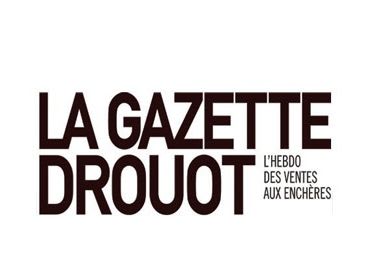
Ray Metzker Abstractions
Zaha Redman, La Gazette Drouot, 7 April 2017 This link opens in a new tab.
Regardez voir
Brigitte Patient, France Inter, 2 April 2017
15 lieux 100% photo
Beaux Arts, 1 April 2017 This link opens in a new tab.
Paris, la photo et le noir et blanc
Eva Ben Dhiab, Untitled magazine, 31 March 2017
Ray K. Metzker, Ombre et lumière
Louise Prothery, L'Express Styles, 29 March 2017 This link opens in a new tab.
Ray Metzker ou le maître du noir et blanc
Lisa Miquet, Konbini, 21 March 2017
Ray K Metzker's Abstractions - in pictures
The Guardian, 20 March 2017
Ray Metzker à la galerie Les Douches
Claire Guillot, Le Monde, 17 March 2017 This link opens in a new tab.
Critique d'expo : Ray Metzker, Abstractions
Elise Boutié, Time Out, 8 March 2017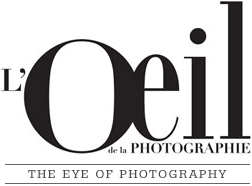
Ray Metzker Abstractions
William A. Ewing, L'Oeil de la photographie, 4 March 2017
Ray K. Metzker - Abstractions
Frédérique Chapuis, Télérama Sortir, 4 March 2017 This link opens in a new tab.
There are a good numbers of living photographers whose careers span more than a half-century but not many whose art shows as much as vitality as that of the American photographer Ray K. Metzker. Few of his peers can match his visual acuity, and capacity of renewal. Rare is the photographer who can strike as skillful a balance between formal brilliance and a tender gender for the world; rare, too, is the rigorous formalist who can also entertain - as Metzker does with his visual puns, puzzles, and occasional pyrotechnics.
The photographer's subject matter is widely varied but, considered retrospectively, its diverse threads coalesce into a coherent tapestry. One of the lengthiest threads in this richly woven fabric is the modern American city, with its morose inhabitants scurrying through dark canyons stabbed by shards of light (….).
Today, looking back at the past fifty years of his photography, Metzker is struck by the centrality of "the street" in his work: first as a springboard for a successful career, then irregularly over the years as a rich mine of imagery (and is the photographer himself not another "city driller"?).[1] Metzker believes he will never exhaust its possibilities. Looking back, he is also surprised to see how often he has focused on actual street surfaces, with nothing other than their much - abused asphalt, paint markings, and puddles with their reflections as his subject matter. "The street is the stage for much human interaction" he notes. "First, I am looking down at it all, closely...and then I move the camera up and focus on what is moving along, the flow of men and women, appearing, disappearing, pulsating...."[2]
At the risk of gross oversimplification one might say than Metzker's voyage has led him from the essentially dark, punctuated with light, to the essentially light, punctuated with dark; or, from a negative to a positive world (....).
Many accomplished photographers, having achieved a mature-style, are then content to stick with the tried-and-true, at the risk of a certain staleness. What rewards the eye in Metzker's work, year after year, decade after decade, is the constant visual and conceptual refreshment. He obviously delights in pushing himself and his medium, forward (...).
Anyone familiar with American photography will feel the spirit of Harry Callahan in Metzker's work. Although the influence itself is clear, Metzker's own explanation of it is nuanced. During their time together as teacher and student at Chicago's Institute of Design, Metzker recalls, “Harry never showed any of his own photographs"[3]. Nor did Callahan give technical advice. It was what went unsaid that was to have a great impact on Metzker: " the idea that you could do it on your own, follow your own vision, make real "art"[4]. It’s true that a number of Callahan images are remarkably similar in feel to Metzker's, but the latter insists he had not seen them at the time, and indeed, Metzker's images sometimes predate similar ones of Callahan’s.
Metzker delights in darkroom experimentation. His negative is only the halfway point of the journey. It's the positive print that counts, and although the negatives that will lead the print have been taken with meticulous care, they are but raw material in the dark room. He sees the camera itself as "a vacuum cleaner, sucking up every detail in the frame".[5] (...) Sometimes he finds something unexpected in the image, and works to bring that out; at other times, he suppresses details. The material may "prove unwillingling", or may simply not live up to the original enounter. (...) Metzker is sometimes amazed that an extraordinary picture may emerge from a negative he'd virtually written off at first glance. And then, if he is observant, "something jumps, glows, flutters... and we pluck a few threads from reality and weave them into another reality, perhaps producing a package of wonder, formed of light and silver, with poetical and mysterial charms."[6]
Metzker's open-mindedness also explains why certain works are given two widely separated dates: 1964-2007, for example. In such instances, the photographer had exposed a batch of negatives decades ago but had never gotten around to doing anything with them. This may have been either because he was simply too busy with other things, or because he didn't quite know what to do with them. So, although the "seeds" may appear to have lain dormant all these years, in fact the period has been one of slow gestation. Metzker has always been content to let things grow organically. Unlike most photographers who are driven by the here-and-now Metzker has taken the long view, and his patience has paid off. Rarely has a photographer's œuvre achieved comparable richness and depth.
Wordsworth one wrote of « the still, sad music of humanity » - a particularly apt description of Metzker’s city folk. Indeed, music is a useful metaphor for Metzker’s photography (…). Many other observers have heard echoes of music in Metzker’s work, not least the artist himself, who has admitted, « music is my muse »[7].
Conversely, silence is another useful concept in dealing with Metzker’s work. The dark surfaces, stabbed with light, are not necessarily about emptiness: light needs darkness, as sound needs silence; "Without silence », Metzker has said « we cannot really hear the subject that needs attention »[8]. Uncontrolled sound or noise drowns out the message and, in equivalent visual terms, overwhelms beauty. Successful form implies control, balance, and the filtering out of what the photographer disdains as ‘the excessive traffic of the obvious".
William A. Ewing
Director of Musée de l’Elysée (1996-2010)
Excerpts from the preface by William A. Ewing, published in 2008 in Light Lines, Steidl, on the occasion of the retrospective exhibition Ray K. Metzker: Light Lines, organized by the Musée de l’Elysée.
[1] The term « city drillers » was suggested by the American writer Thomas Wolfe, whose books Look Homeward Angel and You can’t go home again Metzker’s read in those formation years, 1957-1958, while involved with the Loop in Chicago.
[2] In conversation with the author, Philadelphia, March 2008
[3] In conversation with Nathalie Herschdorfer, Philadelphia, January 2007
[4] In conversation with Nathalie Herschdorfer, Philadelphia, January 2007
[5] In conversation with Nathalie Herschdorfer, Philadelphia, January 2007
[6] Anne Tucker, Unknown Territory, 16
[7] In conversation with Nathalie Herschdorfer, Phliadelphia, January 2007
[8] Anne Tucker, Unknown Territory, 15
Related artist
Les Douches la Galerie
5, rue Legouvé
75010 Paris
+33 1 78 94 03 00
contact@lesdoucheslagalerie.com
Du mercredi au samedi de 14h à 19h
Ou sur rendez-vous










